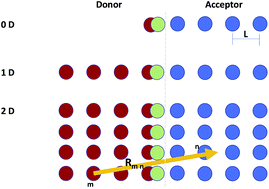Exciton dissociation and charge separation at donor–acceptor interfaces from quantum-classical dynamics simulations
Abstract
In organic photovoltaic (OPV) systems, exciton dissociation and ultrafast charge separation at donor–acceptor heterojunctions both play a key role in controlling the efficiency of the conversion of excitation energy into free charge carriers. In this work, nonadiabatic dynamics simulations based on the quantum-classical Liouville equation are employed to study the real-time dynamics of exciton dissociation and charge separation at a model donor–acceptor interface. Benchmark comparisons for a variety of low dimensional donor–acceptor chain models are performed to assess the accuracy of the quantum classical dynamics technique referred to as the forward–backward trajectory solution (FBTS). Although not always quantitative, the FBTS approach offers a reasonable balance between accuracy and computational cost. The short-time dynamics of exciton dissociation in related higher-dimensional lattice models for the interface are also investigated to assess the effect of the dimensionality on the first steps in the mechanism of charge carrier generation.

- This article is part of the themed collection: Quantum effects in complex systems


 Please wait while we load your content...
Please wait while we load your content...